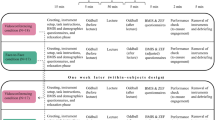Abstract
Videoconferencing over the Internet is developing into a valuable communicative tool, therefore assessment methods allowing users’ requirements to be determined and accounted for in the design of applications are vital. Subjective rating scales are mainly used to assess whether multimedia quality is sufficient for a particular task, however relying on this method alone has drawbacks. Therefore, we are investigating the use of objective methods to assess the user cost of different levels of multimedia quality: physiological indicators of stress are being measured. Two aims of this research are 1) to determine the optimum and minimum levels of quality which different users require for performing different tasks without significant user cost and 2) to produce a utility function which will allow the application to receive physiological feedback on the user.
Preview
Unable to display preview. Download preview PDF.
Similar content being viewed by others
References
Anderson, A.H., Smallwood, L., MacDonald, R., Mullin, J., Fleming, A.: Video data and video links in mediated communication: What do users value? To appear in International Journal of Human Computer Studies (1999/2000) (in press)
Bouch, A., Sasse, M.A.: Network quality of service: What do users need? In: 4th International Distributed Conference, Madrid, September 22nd-23rd (1999)
Bouch, A., Watson, A., Sasse, M.A.: QUASS. A tool for measuring the subjective quality of real-time multimedia audio and video. In: Proceedings of HCI 1998, Sheffield, UK, September 1-4 (1998)
Cacioppo, J.T., Louis, G.T.: Inferring psychological significance from physiological signals. American Psychologist 45(1), 16–28 (1990)
Cannon, W.B.: The Wisdom of the Body. WW Norton, New York (1932) (Reprinted 1963)
Edelberg, R., Wright, D.J., Two, G.S.R.: effector organs and their stimulusspecificity. Paper read at the Society for Psychophysiological Research, Denver (1962)
ETNA Project, http://www-mice.cs.ucl.ac.uk/multimedia/projects/etna/
Frijda, N.H.: The Emotions, chapter Physiology of Emotion. In: Studies in Emotion and Social Interaction, pp. 124–175. Cambridge University Press, Cambridge (1986)
Gatchel, R.: Biofeedback. In: Baum, A., Newman, S., Weinman, J., West, R., McManus, C. (eds.) Cambridge Handbook of Psychology, Health and Medicine. Cambridge University Press, Cambridge (1997)
Gilli Manzanaro, J., Janez Escalada, L., Hernandez Lioreda, M., Szymanski, M.: Subjective image quality assessment and prediction in digital videocommunications. COST 212 HUFIS Report (1991)
ITU-R BT.500-8 Methodology for the subjective assessment of the quality of television pictures: http://www.itu.int/publications/itu-t/iturec.htm
Kitawaki, N., Nagabuchi, H.: Quality assessment of speech coding and speech synthesis systems. IEEE Communications Magazine, 36–44 (October 1998)
Knoche, H., De Meer, H.G., Kirsh, D.: Utility curves: mean opinion scores considered biased. In: Proceedings of 7th International Workshop on Quality of Service, pp. 12–14 (1999)
LeDoux, J.: The Emotional Brain. Simon and Schuster, New York (1996)
Millard, N., Coe, T., Gardner, M., Gower, A., Hole, L., Crowle, S.: The future of customer contact. British Telecom Technology Journal (1999), http://www.bt.co.uk/bttj/vol18no1/today.htm
O’Malley, C., Anderson, A.H., Mullin, J., Fleming, A., Smallwood, L., MacDonald, R.: Factors Affecting Perceived Quality of Digitised Video: Tradeoffs between Frame Rate, Resolution and Encoding Format. Submitted to Applied Cognitive Psychology, forthcoming
Picard, R.W.: Affective Computing. M.I.T. Press, Cambridge (1997)
Picard, R.W., Healey, J.: Affective wearables. In: Proceedings of the First International Synopsium of on Wearable Computers, Cambridge, MA (October 1997)
Sasse, M.A., Biltung, U., Schulz, C.-D., Turletti, T.: Remote seminars through multimedia conferencing: experiences from the MICE project. In: Proceedings of INET 1994/JENC5 (1994a)
Seyle, H.: The Stress of Life. McGraw-Hill, New York (1956)
Thought Technology Ltd., http://www.thoughttechnology.com/
Vyzas, E., Picard, R.W.: Offline and online recognition of emotion expression from physiological data. In: Workshop on Emotion-Based Agent Architectures. Third International Conference on Autonomous Agents, Seattle, WA (1999)
Watson, A., Sasse, M.A.: Multimedia conferencing via multicast: determining the quality of service required by the end user. In: Proceedings of AVSPN 1997. International Workshop on Audio-visual Services over Packet Networks, pp. 189–194 (1997)
Watson, A., Sasse, M.A.: Measuring perceived quality of speech and video in multimedia conferencing applications. In: Proceedings of ACM Multimedia 1998, Bristol, UK, September 1998, pp. 55–60. ACM, New York (1998)
Wilcott, R.C.: Arousal Sweating and Electrodermal Phenomena. Psychological Bulletin 67, 58–72 (1967)
Wilson, F., Descamps, P.T.: Should we accept anything less than TV quality: Visual communication. In: International Broadcasting Convention, September 12th-16th ( 1996)
Author information
Authors and Affiliations
Editor information
Editors and Affiliations
Rights and permissions
Copyright information
© 2000 Springer-Verlag Berlin Heidelberg
About this chapter
Cite this chapter
Wilson, G.M., Sasse, M.A. (2000). Listen to Your Heart Rate: Counting the Cost of Media Quality. In: Paiva, A. (eds) Affective Interactions. IWAI 1999. Lecture Notes in Computer Science(), vol 1814. Springer, Berlin, Heidelberg. https://doi.org/10.1007/10720296_2
Download citation
DOI: https://doi.org/10.1007/10720296_2
Publisher Name: Springer, Berlin, Heidelberg
Print ISBN: 978-3-540-41520-6
Online ISBN: 978-3-540-44559-3
eBook Packages: Springer Book Archive




